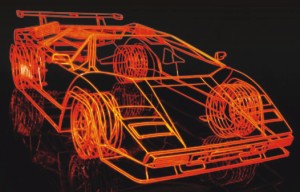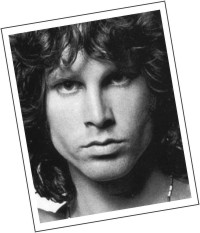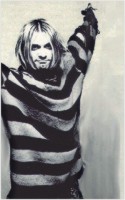
While some of these pictures may look like computer generated drawings, they are actually full scale wireframe representation of a Lamborghini Countach created by installation artist Benedict Radcliffe. The car is the latest in a series of wire cars Radcliffe has completed. It's likely the most ambitious, painstakingly crafted from 10 mm steel tube welded together into that familiar shape we all know and secretly love. Upon close inspection you see fine details in the wheels and the intake gills, even the letters spelling "Pirelli P7" are worked out in tubing. We contacted Benedict to find what was behind his impressive creation and it turns out he's a real car guy, and a serial wireframe artist.

His story below.
I have always been fascinated by cars and from an early age used to go with my god father to brands hatch race track. He belonged to the Aston Martin owners club and so would accompany him to the races. We would often go into the paddock and see all the cars being tuned and tweaked- I'm sure this is where I came across for the first time a Lamborghini, and it made a lasting impression.
 In 2005 I made my first wireframe car, a Subaru Impreza P1. I called it 'Modern Japanese Classic'. A Subaru was chosen for many reasons; it was at the time a joy-riders favourite, it was my preferred car when playing Gran Turismo on Playstation, but really its charm comes from the fact that despite being very, very fast, underneath the lowered alloys and fat spoilers lurks a family saloon (albeit on steroids!).
In 2005 I made my first wireframe car, a Subaru Impreza P1. I called it 'Modern Japanese Classic'. A Subaru was chosen for many reasons; it was at the time a joy-riders favourite, it was my preferred car when playing Gran Turismo on Playstation, but really its charm comes from the fact that despite being very, very fast, underneath the lowered alloys and fat spoilers lurks a family saloon (albeit on steroids!).
With the Lamborghini I made it because I just knew the wireframe technique would suit it and it is the most iconic supercar of all time. I had to make it to get it out of my system.
It was a fun project, I loved doing the little details like the pepper pot wheels and Pirelli P7 tyres, the Koenig side spoilers and air intakes, and of course the rear spoiler- It looks so simple but it took ages because it's all about the economy of line too much steel and it becomes unsophisticated and not enough and it doesn't represent it sufficiently.
I chose the fluro orange because like the car it is uncompromising! It's aggressive and has attitude. It also looks great when the car is either set in the street or photographed against a white background.”
The car is currently on display at the Classic Car Club UK, a genius organization with a collection of cars the members collectively drive. If you're interested the Countach is indeed for sale or, if the right opportunity comes along, a lease.
Via: Jalopnik


By Naveed Nawshad
Peace, love, and empathy,” were strangely enough the last words written on the late Kurt Cobain's suicide note before pointed his six pound .20 gauge Remington shotgun into his mouth and pulled the trigger. Cobain ended his own life on April 5, 1994 after taking enough heroin to kill three people. The big question is how could a person of such creativity and talent, not to mention fame and fortune, want to end his life? Kurt Cobain was a voice of a generation and has widely been hailed as the “John Lennon of his generation.” According to the Analytic theories, Jung would have regarded him as being both “ahead of his time” and in touch with a source of superior wisdom, the collective unconscious.
Kurt Cobain was an energetic, talented and creative child who liked to draw and sing Beatles tunes. By the time he was eight years old his parents were already divorced. This was an emotional holocaust for Kurt and no other single event in his life had more of an effect on the shaping of his personality. Kurt could not understand the reason for the divorce and he, like most children who go through this, thought it was his fault. He kept his anguish and grief inside rather than outwardly expressing it. He even proceeded to write on his bedroom wall: I hate mom, I hate dad, dad hates mom, mom hates dad. It simply makes you want to be so sad.
A once a fearless, outgoing child before the divorce was now a tentative ten-year-old, always waiting for the other person to make the first move. By the time he was eleven, Kurt was talking back to adults, refusing to do chores, and, despite his small size, began to bully another boy with such force that the victim refused to go to class. Teachers and parents became involved, and everyone wondered why such a sweet boy had turned so rancid. He was definitely deeply and permanently hurt by his parents divorce.
 Born in 1967, he was one of the growing wave of children who, since the '60s and '70s, have been exposed to addictive, mind-altering drugs under the guise of “medication.” At school he was diagnosed as hyperactive and given the drug Ritalin. Ritalin acts as a tranquilizer in children and is very addictive. In Kurt's case, Ritalin kept him awake and consequently sedatives were prescribed to counteract it. Kurt remained a poor student and eventually dropped out of high school in the 12th grade. It seems that the divorce of his parents was the key factor in pointing Kurt in a downward spiral. It is possible that this one event underpinned everything from his later drug addiction, to his severe physical problems, to his irrational behavior and finally to his suicide.
Born in 1967, he was one of the growing wave of children who, since the '60s and '70s, have been exposed to addictive, mind-altering drugs under the guise of “medication.” At school he was diagnosed as hyperactive and given the drug Ritalin. Ritalin acts as a tranquilizer in children and is very addictive. In Kurt's case, Ritalin kept him awake and consequently sedatives were prescribed to counteract it. Kurt remained a poor student and eventually dropped out of high school in the 12th grade. It seems that the divorce of his parents was the key factor in pointing Kurt in a downward spiral. It is possible that this one event underpinned everything from his later drug addiction, to his severe physical problems, to his irrational behavior and finally to his suicide.
As a child, Kurt Cobain did not know how to deal with his feelings and this carried on through adulthood. He kept his emotions inside and let his anxieties and frustrations get the best of him. This was not a healthy way to live. Besides finding a release by getting high with local stoners during high school, Kurt also found a way out through art. He demonstrated artistic ability at an early age, and his collages, sculptures and other artworks adorn many of Nirvana's records. If he had not become a musician, he might well have pursued a career in the visual arts. With all of the emotional scars left from his early childhood, Kurt Cobain still had the motivation to create. According the Analytic theories, Jung believed that while an individual is affected by the environment, they are intrinsically motivated and reinforced, which gives them the tendency to be nonconforming. This holds true because the theory states that the information provided by the unconscious is the source of the individual's strength in resisting external motivation and reinforcement.
Kurt Cobain was definitely not one to conform. He didn't fit in with the macho stereotype imposed on young males in his hometown of Aberdeen, Washington. He was also harassed at high school for befriending a gay student. At age 14, Kurt's fate took a new course when his father bought him his first electric guitar.
Kurt Cobain had found a way to deal with his feelings. He discovered an outlet from his emotions through music. Although the band was really successful, Cobain was a reluctant, unwilling spokesman for his generation. He was uneasy with notoriety. A misfit within the institution called rock and roll, Kurt Cobain's punk values put him at odds with rock stardom that the world was so eager to thrust upon him. In the song “Radio Friendly Unit Shifter” from Nirvana's 3rd album In Utero, Kurt even went as far as to declare “I do not want what I have got.”
So with all this fame and fortune, why was Kurt Cobain still unhappy? He had some sort of repressed conflict. Through out his whole life, all he ever wanted was to have a normal family. The downward spiral starts when his parents get divorced. He keeps inside the fact that he is really upset about it. It is possible that Cobain was still unhappy with all the fame because he still knew that his life was messed up. The fact remained that his parents were not together, he was severely addicted to heroin hard drugs, and adding considerably to Cobain's unhappiness was his chronic, un-diagnosable stomach pain that tortured him for the rest of his life. Could it be that the source of Kurt Cobain's creativity was unconsciously his pain and suffering? The Analytic theories state that the creative process consists of bringing information from the unconscious into consciousness. According to Freud, the unconscious houses creative information that has been repressed for one reason or another.
Cobain used his active imagination to intentionally create a new type of music known as grunge that had an extraordinarily powerful effect on the masses during the '90s. He intentionally wore raggedy clothes and played beat up guitars to be different than the hair bands of the early 90's. This also gave Cobain a true connection with the teenage angst of his generation because in their eyes, he was one of them.
Kurt Cobain was a true visionary and music genius. Unfortunately, his life was short-lived. Cobain refused to get help for his drug addiction, which was a creative block that was used to forget about the pain and depression.
His drug addiction only made things worse. In desperation, wife Courtney Love and several friends enrolled Cobain in a psychiatric drug recovery center. Thirty-six hours after admission, he left the program and in a small room above his garage in a quiet Seattle neighborhood, ended his life. In his suicide note, he alluded to two things that had brought him to suicide: the stomach pain that had haunted him for years, and his agony over his music, about which he wrote, “I don't have the passion anymore.”
Jim Morrison, the singer of the legendary band The Doors, is perhaps the most unappreciated and misunderstood artist of his time. In 1969, after his last concert in Miami, Florida the media turned their back on him labeling him as primitive and Florida's state law system accused him of public exposure and misbehavior, but the real perspective about Jim Morrison is that he had one of those gifts that few people have of making you feel the most important person in the world. Jim Morrison had an enigmatic childhood, a romantic personality and a tremendous sense of the absurd.
Jim's childhood represent the guide to the Labyrinth. His father, George Morrison, was an admiral of the navy which position required him to move around the United States. This fact leads to the conclusion that the Morrison family was strongly influenced by what we call “Male Institutions.”
This home instability created in Jim the need to develop affection for things that would stay in the same place. Jim Morrison never owned a house; he preferred to stay with friends or girlfriends for short periods of time until his death in 1971.
In 1949, Jim Morrison was driving with his parents through the New Mexico desert and they came across a terrible accident in the middle of the road. According to Jim, a truck loaded with a tribe of Navajo Indians had turned over and the Indians were scattered along dawn's highway crying and bleeding to death. Jim at the age of five was shocked by the scene in which he claimed that the soul of the shaman jumped on him just after leaving the shaman's body and took possession of his soul, since then.
Jim Morrison was a sensitive person. He only had one big love in his life, her name was Pamela Courson. They met each other while Jim was living in Venice, California. One day, Pamela was walking her dog on Sunset Strip Boulevard and came across Jim. He was in shock by her beautiful figure and later on by her amazing personality. He was so enchanted that he did not hesitate to follow her from the boulevard to the famous Love Street and waited until dusk hidden behind a bush. Right after dusk, he decided to do the impossible and climbed an apple tree and jumped on to Pamela's deck. Jim found Pamela standing next to the door watching him risk his life just to introduce himself. Once Jim was facing Pamela, she calmly asked him “Do you have a problem with doors?” Jim answer was a short, but passionate “sometimes…” followed by a soft warm kiss. After that Jim vanished into the night saying “You are the one.”
During the next ten years, they had a wonderful relationship even after Jim moved to France to get clean of all the wild experiences that he has had while he was living in America. Three years after Jim Morrison's death, Pamela Courson died of a heroin overdose with the excuse to meet Jim in the afterlife.
For most people absurd means something without meaning or logic, but for Jim absurd was a way to express himself through the rearrangement of the senses in order to achieve knowledge and meaning. Took many years and experiences for Jim's sense of the absurd met its highest level with the lyrics of the song “The End” in which he was terrible misunderstood by everyone. Like Oedipus Rex says at the end of his work, “Kill the alien concepts'. 'Get back to reality' is precisely what the song is about. His biggest hit was the song ' Light my fire! '
In Brief, Jim Morrison was an incredible character able to express his soul throughout his lyrics. This capacity of expression came out to be a representation of his experiences during his life. His death in 1971 left an incredible sadness in every single one of his fans, friends, and relatives. This feeling will never disappear and the echo of his essence will last through ages awarding him the fame and glory as a great Poet!
Flashgames Series

By Sabrina F Ahmad
Christmas is supposed to be time for fun and games, and that also applies to flashgames. This week, we have three holiday-themed flashgames for you to try
 Holiday Express
Holiday Express
If you like puzzle games, Puzzle Express a neat treat. Developed and published by Hipsoft, the game-play merges elements of Tetris and your basic jigsaw puzzle to create hours of entertainment. The game shows trains arriving at the station, with blocks arriving on a conveyer belt, which you race against the clock to load onto the truck, which is fitted with a basic grid. As each row is covered up, a picture emerges, so that the completed grid shows a snapshot.
Holiday Express is the holiday-themed version of the same game, with the blocks designed to look like Christmas gifts, and the finished photographs revealing celebration scenes. The graphics are simple and colourful, and closely resemble your basic Tetris game. This is definitely a game that allows you to unwind and have some fun.
 Holiday Bejeweled
Holiday Bejeweled
This is for people who like match games. The objective is to match three or more of the same colour/jewel in a row (up or down), as soon as you match a set the jewels will disappear and new ones will appear up top. To move the gems around, you click on two adjacent gems to swap their places. You can only switch the gems place to finish a matching set. While this might seem a little complicated, it is actually pretty easy
There are two different modes to play in: Timed, where you have a time goal, and Normal, where players try to match as many as they can till there is nothing more to match up. When there is not more jewels to match up, the game will end.
The graphics are pretty simple, with explosive sound effects to add to the feeling of the game. While it may not sound all that much, Bejeweled is one of the most addictive games on the Web.
Christmasville
 This review would definitely be incomplete without at least one hidden-object game. Published by NevoSoft, the storyline features Santa, who's gone missing, leaving the North Pole in a frenzy as Christmas approaches. You play the role of super-sleuth Arthur Knight, who has to study the clues to recover Father Christmas. The main game-play involves seeking out a list objects from crowded pictures, but there are also mini-games where you have to unscramble letters to decode mysterious messages, or play memory card games, where you match cards to eliminate them, or even mini-jigsaws where you have to fit the pieces of a picture together. Throughout the game, you meet interesting characters in this charming whodunnit, some of whom are on your side, and some who are working against you. The illustrations and graphics are reminiscent of Dr Seuss books, while the characters and storyline will remind you of Discworld characters, particularly when the Grim Reaper makes an appearance. Adding to the whole theme, the soundtrack consists of instrumental versions of popular carols, creepy music when you arrive at the abode of Death, and more. This is definitely a game for those who demand a little more variety from their flashgames.
This review would definitely be incomplete without at least one hidden-object game. Published by NevoSoft, the storyline features Santa, who's gone missing, leaving the North Pole in a frenzy as Christmas approaches. You play the role of super-sleuth Arthur Knight, who has to study the clues to recover Father Christmas. The main game-play involves seeking out a list objects from crowded pictures, but there are also mini-games where you have to unscramble letters to decode mysterious messages, or play memory card games, where you match cards to eliminate them, or even mini-jigsaws where you have to fit the pieces of a picture together. Throughout the game, you meet interesting characters in this charming whodunnit, some of whom are on your side, and some who are working against you. The illustrations and graphics are reminiscent of Dr Seuss books, while the characters and storyline will remind you of Discworld characters, particularly when the Grim Reaper makes an appearance. Adding to the whole theme, the soundtrack consists of instrumental versions of popular carols, creepy music when you arrive at the abode of Death, and more. This is definitely a game for those who demand a little more variety from their flashgames.
